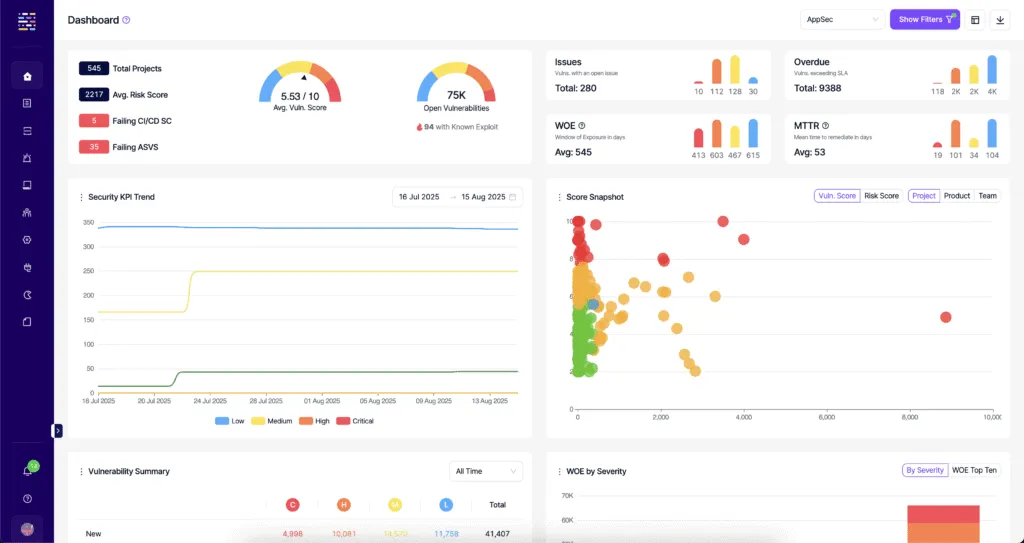Top 10 ASPM tools for 2025
Application security posture management (ASPM) all tools promise unified visibility, but in 2025, the real differentiator is validated, actionable results. This post ranks the top 10 ASPM tools, highlighting Invicti’s proof-based ASPM platform that combines AppSec orchestration with proven vulnerability validation.

What is ASPM (application security posture management)?
Application security posture management (ASPM) is an area of cybersecurity that centralizes application security testing signals across development and runtime, correlating and prioritizing security issues in one place so teams can focus on the highest-risk vulnerabilities. In practice, ASPM typically unifies data from DAST, SAST, SCA, IAST, container security, API security testing, and other types of tooling to give visibility across the entire attack surface, enable security policy enforcement, and support remediation across the software development lifecycle (SDLC).
ASPM tools: Going beyond posture management
As application security posture management tools continue to gain traction in 2025, organizations are coming to realize that getting an ASPM is only half the visibility story. While ASPM platforms promise centralized visibility and integration across the AppSec stack, they often fall short in practice when it comes to enabling actionable results and measurable security improvements.
Most often, the problem comes down to data quality: unless you can validate testing results to determine real risk, you are also centralizing and accumulating noise alongside actionable signals. Unless findings are verified and prioritized by exploitability and business risk, false positives can overwhelm security engineer and developer workflows to the point where application security stops being scalable.
In 2025, the most effective AppSec programs are built around ASPM platforms that don’t merely aggregate data but can orchestrate testing, prioritize findings, and help you actually secure your applications. Verified inputs are what drive prioritization in ASPM, making exploitability a key data point – and accurate dynamic application security testing (DAST) is a crucial source of that information.
Here are the top 10 ASPM tools for 2025, ranked not just for their feature sets but also for how effectively they help teams find, prove, and fix real security risks.
ASPM vendors and ASPM tools
1. Invicti ASPM
Invicti ASPM (formerly Kondukto) is designed to give security teams a central system of record for application security while cutting through the noise that plagues many posture management tools. It ingests findings from across the AppSec stack and correlates them into a single, policy-driven view, helping teams prioritize work and enforce consistent security standards across development and operations. It can also deduplicate findings and even automatically trigger scans from connected tools – and that’s a big deal when you have a dozen or more scanners to operate.
But what makes Invicti ASPM unique is its deep integration with Invicti DAST. Unlike most ASPM solutions that simply aggregate and process scan data, Invicti ASPM can also validate issues in running applications through proof-based scanning. This means your application posture metrics and dashboards reflect real, exploitable risks rather than raw, unverified findings.
Selected Invicti ASPM benefits:
- Unified AppSec orchestration: Invicti ASPM aggregates results from your existing AppSec tools and pipelines, including DAST, SAST, SCA, API testing, and container and secrets scanners, and presents them on a single dashboard for 360° visibility of application risk.
- Intelligent risk prioritization: The platform correlates runtime-validated DAST findings with static scan data to prioritize truly exploitable vulnerabilities. Feeding Invicti’s proof-based (verified) DAST results into the ASPM engine highlights exploitable issues that cannot be false positives, so teams can focus on issues that have been proven to carry runtime risk.
- AI-assisted remediation: Invicti ASPM provides AI-driven remediation guidance and automated workflows to streamline fixes. For example, it can generate recommendations for code patches or configuration changes and integrate with ticketing systems such as Jira to route high-priority issues directly to the responsible developers.
- Workflow automation: The platform lets users define custom workflows and policies to automate AppSec processes. Common use cases include auto-creating tickets for critical findings, enforcing security gates in CI/CD pipelines (e.g. blocking a release if a high-severity vuln is found), and sending notifications to relevant teams.

Why Invicti ASPM is #1: In 2025, posture management without validation is incomplete. Invicti ASPM connects orchestration, governance, and reporting with DAST-verified vulnerability data, enabling accurate prioritization and measurable posture improvement while saving you time and money.
Learn more about Invicti’s proof-based ASPM
2. ArmorCode
ArmorCode positions itself as an independent, tool-agnostic ASPM layer that unifies findings across SAST, DAST, IAST, SCA, container, and cloud security for enterprise-scale governance. Its risk-based vulnerability management correlates severity, exposure, and business context, with automation to reduce manual steps and help remediation.
Best for: Large organizations that want a broad integration ecosystem and centralized risk management without changing their existing scanners.
3. Ox Security
Ox markets “Active ASPM” that combines native scanning across the SDLC with context-aware risk scoring, PBOM lineage, and attack-path analysis. It emphasizes no-code workflow automation and claims significant noise reduction through context-based filtering.
Best for: Teams leaning into software supply chain protection and pipeline-centric security with integrated SAST, SCA, IaC, container, and cloud checks.
4. Apiiro
Apiiro presents what it calls a “code risk platform” that builds a continuous risk graph and applies deep context to prioritize issues by business impact and exploitability. Its automation uses risk-based guardrails in pull requests and CI.
Best for: Engineering-led programs that want granular code-level context tied to architecture and runtime signals.
5. Cycode
Cycode offers an all-in-one platform with correlated proprietary scanners for SAST, SCA, secrets, IaC, CI/CD, and containers. It aims to cover code to deployment in one product while still ingesting external tools via connectors.
Best for: Teams standardizing on a single vendor suite with the flexibility to bring other findings into one dashboard.
6. Jit
Jit is a developer-centric platform that prepackages SAST, SCA, DAST, secrets, and IaC checks into “security plans,” running scans on commits and PRs with in-workflow feedback. It focuses on automation and basic posture metrics to help small teams ramp up quickly.
Best for: Startups and agile teams that want pragmatic shift-left coverage with lightweight ASPM reporting.
7. Snyk
Snyk is a developer security platform that unifies SCA, SAST, container, and IaC in a single interface integrated into developer tools. Its ASPM adds context for prioritization and accelerates fixes with automated PRs and guidance.
Best for: Developer-first organizations consolidating multiple AST modalities into everyday workflows.
8. Black Duck
Black Duck specializes in software composition analysis for open-source risk, compliance, and SBOMs, feeding results into Synopsys Software Risk Manager to support ASPM dashboards. It is designed for enterprise scale and pairs with SAST and other tools for a fuller posture view.
Best for: Enterprises prioritizing open-source governance as a core pillar of application security posture.
9. Aikido
Aikido positions itself as an all-in-one, developer-first platform that combines SAST, DAST for web apps and APIs, SCA, secrets, IaC/CSPM, and container scanning with AI-assisted triage. The emphasis is broad coverage, ease of use, and faster fixes.
Best for: Smaller development teams without existing security tooling who want unified coverage.
10. Wiz
Wiz is primarily a cloud security platform that can discover cloud assets and correlate issues such as misconfigurations and vulnerabilities with runtime context. Its ASPM capabilities complement development-focused tools by showing where application risk is critical in the deployed environment and by automating compliance.
Best for: Organizations with large cloud footprints that need runtime context to drive application risk decisions.
Final thoughts: ASPM tooling is just the beginning
ASPM gives you a single place to see and govern application risk, but runtime-validated findings are what really turns backlog items into actionable insights for mitigation. AppSec programs and solutions that combine ASPM capabilities with accurate DAST as a security posture gauge can drive real risk reduction and prioritize fixes where they matter most – and with Invicti, you get the unquestioned #1 DAST tool as your ASPM fact-checker.


